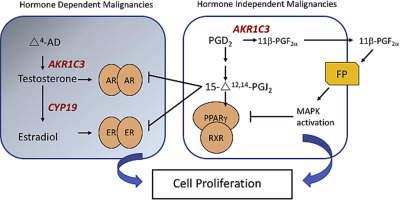当前位置:
X-MOL 学术
›
Mol. Cell. Endocrinol.
›
论文详情
Our official English website, www.x-mol.net, welcomes your
feedback! (Note: you will need to create a separate account there.)
AKR1C3 (type 5 17β-hydroxysteroid dehydrogenase/prostaglandin F synthase): Roles in malignancy and endocrine disorders.
Molecular and Cellular Endocrinology ( IF 3.8 ) Pub Date : 2018-09-19 , DOI: 10.1016/j.mce.2018.07.002
Trevor M Penning 1
Molecular and Cellular Endocrinology ( IF 3.8 ) Pub Date : 2018-09-19 , DOI: 10.1016/j.mce.2018.07.002
Trevor M Penning 1
Affiliation

|
Aldo-Keto-Reductase 1C3 (type 5 17β-hydroxysteroid dehydrogenase (HSD)/prostaglandin (PG) F2α synthase) is the only 17β-HSD that is not a short-chain dehydrogenase/reductase. By acting as a 17-ketosteroid reductase, AKR1C3 produces potent androgens in peripheral tissues which activate the androgen receptor (AR) or act as substrates for aromatase. AKR1C3 is implicated in the production of androgens in castration-resistant prostate cancer (CRPC) and polycystic ovarian syndrome; and is implicated in the production of aromatase substrates in breast cancer. By acting as an 11-ketoprostaglandin reductase, AKR1C3 generates 11β-PGF2α to activate the FP receptor and deprives peroxisome proliferator activator receptorγ of its putative PGJ2 ligands. These growth stimulatory signals implicate AKR1C3 in non-hormonal dependent malignancies e.g. acute myeloid leukemia (AML). AKR1C3 moonlights by acting as a co-activator of the AR and stabilizes ubiquitin ligases. AKR1C3 inhibitors have been used clinically for CRPC and AML and can be used to probe its pluripotency.
中文翻译:

AKR1C3(5型17β-羟基类固醇脱氢酶/前列腺素F合酶):在恶性肿瘤和内分泌疾病中的作用。
Aldo-酮基还原酶1C3(5型17β-羟基类固醇脱氢酶(HSD)/前列腺素(PG)F2α合酶)是唯一不是短链脱氢酶/还原酶的17β-HSD。通过充当17-酮类固醇还原酶,AKR1C3在周围组织中产生有效的雄激素,从而激活雄激素受体(AR)或充当芳香酶的底物。AKR1C3参与去势抵抗性前列腺癌(CRPC)和多囊卵巢综合征中雄激素的产生。并且与乳腺癌中芳香化酶底物的产生有关。AKR1C3通过充当11-ketoprostaglandin还原酶,产生11β-PGF2α以激活FP受体,并剥夺过氧化物酶体增殖物激活剂受体γ的推定PGJ2配体。这些生长刺激信号暗示AKR1C3参与非激素依赖性恶性肿瘤,例如 急性髓细胞性白血病(AML)。AKR1C3通过充当AR的共激活物而月光,并稳定泛素连接酶。AKR1C3抑制剂已在临床上用于CRPC和AML,可用于探测其多能性。
更新日期:2018-09-19
中文翻译:

AKR1C3(5型17β-羟基类固醇脱氢酶/前列腺素F合酶):在恶性肿瘤和内分泌疾病中的作用。
Aldo-酮基还原酶1C3(5型17β-羟基类固醇脱氢酶(HSD)/前列腺素(PG)F2α合酶)是唯一不是短链脱氢酶/还原酶的17β-HSD。通过充当17-酮类固醇还原酶,AKR1C3在周围组织中产生有效的雄激素,从而激活雄激素受体(AR)或充当芳香酶的底物。AKR1C3参与去势抵抗性前列腺癌(CRPC)和多囊卵巢综合征中雄激素的产生。并且与乳腺癌中芳香化酶底物的产生有关。AKR1C3通过充当11-ketoprostaglandin还原酶,产生11β-PGF2α以激活FP受体,并剥夺过氧化物酶体增殖物激活剂受体γ的推定PGJ2配体。这些生长刺激信号暗示AKR1C3参与非激素依赖性恶性肿瘤,例如 急性髓细胞性白血病(AML)。AKR1C3通过充当AR的共激活物而月光,并稳定泛素连接酶。AKR1C3抑制剂已在临床上用于CRPC和AML,可用于探测其多能性。

































 京公网安备 11010802027423号
京公网安备 11010802027423号